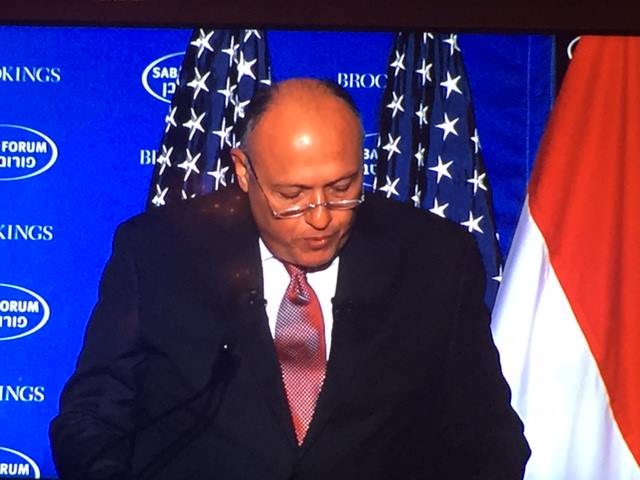Quick strokes of black ink outline the forms of a group of Bedouins seated in front of a blazing fire. The brushstrokes of vivid oranges and red evoke a feeling of warmth in contrast to the bluish hues of the cool night surrounding them.
This Margo Veillon painting, “Bedouins around the fire, was one of the hundreds of works – 396 to be precise – on display at El Hanager Gallery at the Cairo Opera House. Earlier this week The American University in Cairo Press unveiled “1001 Margo Veillon Paintings.
“Uniquely creative and determined, and fiercely independent, Margo Veillon, has for nearly a century, chronicled the very essence of Egyptian daily life, director of AUC Press Mark Linz said.
Ranging from ink sketches, to watercolors, this collection encapsulated Veillon’s passion. It also provided a rare glimpse into Egypt’s transition over the seven decades spanning the artist’s work.
A century after Veillon’s birth in Cairo on February 1906, the exhibition opened on Sunday to crowds of art enthusiasts. And the growing numbers of round, red stickers discreetly placed by the sold works (ranging in price from LE 1,000 to 8,000) were evidence of her immortal popularity.
As the new owners of Veillon’s work hang up the framed drawings in the privacy of their homes, the public still has a chance to glimpse the artwork.
Though not quite the same as gazing at the original, AUC Press offers the next best thing: “Margo Veillon: Witness of a Century. Hot off the presses, the volume is a collection of the work currently on exhibit.
While only a substitute for meandering through the gallery, enjoying the bursts of energy from Veillon’s drawings, the book does have its advantages. First, there are no disruptions by other gallery visitors. Second, the editor Bruno Ronfard provides countless insights into the artist’s work and life that give you a whole other level of appreciation for her work. The contributions by John Rodenbeck and Jill Edwards also create a backdrop of history to further gain an understanding of the factors influencing the artist.
Born in Cairo to a Swiss businessman and his Austrian wife, Veillon was raised in Egypt. She traveled to Paris for a brief stint, only to return in 1931. Consequently, the greater part of her career was spent portraying daily life in Egypt. Although she was based in her Maadi studio, she traveled along the Nile Valley and the surrounding desert, even venturing through Nubia into Sudan and Ethiopia.
As she explored Egypt, she portrayed a traditional lifestyle and countryside that was quickly being swallowed up by modernity in her sketches and drawings. Students in a village school in Maadi, a traditional barber shop and rural celebrations are all immortalized in her work.
Veillon’s quick brushstrokes seem to be conveying a “sense of urgency – as Jill Edwards described it – to record fleeting moments that have been buried in the passage of time.
“From festivals to labor in the fields or the daily life of women, it is not just the reality she lets us see, writes Ronfard, “but more profoundly the secret beauty of the world, with discipline and passion.
Following her 90th birthday in 1997, a special trust agreement was established between Margo Veillon and AUC in order to promote her artistic legacy. The AUC Press now maintains a permanent collection of 100 of Veillon’s masterpieces, in addition to over 5,000 watercolors, drawings, graphics, and other works at the artist’s studio in Maadi. Proceeds from sales from the current exhibition will go to the trust.
If you visit the exhibition at El Hanager, don’t pass up on the chance to take the short walk to the Cairo Opera House Gallery where works from AUC’s permanent Veillon collection is on display. This Masterpiece Collection reveals another depth to her work.
The artist best explains it in her own words: “In my sketches, drawn on the spot and in motion, I am myself – that is, I don’t know whether or not I am aware of what I’m doing. It’s like a spring that gushes forth, whereas painting makes other demands: it calls for awareness, a critical stand as to the decision to be made.
The results are awe-inspiring. In some instances, you see the end result of the sketches in the final oil painting. The free brushstrokes are still there, but the colors are richer, the framing more focused.
John Rodenbeck relates an anecdote that provides a glimpse into the artist’s character.
As he was strolling along the Nile with her she stopped him and said “Look at that! She pointed out a little bird to him. “I looked and looked, Rodenbeck recalled, “and finally saw, at least 150 meters away, a tiny bird perched on the topmost masthead of an anchored felucca, singing. But I also saw what she meant: Here was a miracle, that needed only someone to see it and make it noticed.
This is exactly what Veillon’s work does, make us notice the beauty in a woman engrossed in the daily task of washing her hair, a student’s expression as he concentrates on his class work, or a woman sleeping lazily by a water buffalo.
1001 Margo Veillon PaintingsEl Hanager Gallery, Cairo Opera House, ZamalekThe Masterpiece CollectionCairo Opera House Gallery, ZamalekExhibitions run until Feb 18


